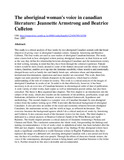| dc.description.abstract | This study is a critical analysis of four works by two aboriginal Canadian women with the broad objective of giving voice to aboriginal Canadian writers, Jeannette Armstrong and Beatrice Culleton. The four works are used as case studies of aboriginal Canadian literature. The study takes a keen look at how aboriginal writers portray aboriginal characters in their fiction as well as the way they define the relationship between aboriginal Canadians and the mainstream society in their writing, keeping in mind that they have been through the colonial experience.
Female writers would be most closely attuned to some of the themes discussed and the choice of female writers, therefore, enables us to tap into the feminine sensibility where sensitive and emotionally charged issues such as family ties and family break-ups, substance abuse and dependence, institutional discrimination, oppression and mass murder are concerned. The work, therefore, singles out traits peculiar to female characters in the narratives, which lead to a better understanding of the role of women in society.
This work is a critical analysis of the images of aboriginal Canadians in works of art. In order to do that effectively, however, it has been necessary to do an overview of Canadian literature in chronological order of date of publication. A wide variety of other works, hard copies as well as information posted online, has also been consulted.
The thesis is then organised into chapters. The first chapter is an introduction into the subject of the study, which also touches on the statement of the problem, justification, scope and limitations, definition of terms, literature review, theoretical framework, hypotheses and methodology. The second chapter is a synoptic view of Canadian literature by non-aboriginal writers from the earliest writing up to 1980. It provides the historical background of aboriginal Canadians. It also provides an outline of the social and economic relations between aboriginal Canadians, the mainstream society, and the world at large, as reflected in literature. This overview becomes the background against which I do a critical analysis of works by Armstrong and Culleton. It also contains much of the literature review [or this study.
The third chapter is dedicated to a critical analysis of Beatrice Culleton's Spirit of the White Bison and April Raintree. The fourth chapter presents a critical analysis of Jeannette Armstrong's Neekna and Chemai and Slash. The conclusion summarises the whole work, foregrounding the findings and making recommendations. A list of works cited, in alphabetical order, has been included after the fifth and last chapter.
Among the most significant of my findings IS that aboriginal writers have made a significant contribution to world literature written in English. Furthermore, they have replaced the image of a defeated self.-mocking aboriginal Canadian with a new proud and lively one, the face of a resilient and wise people. Through the efforts of these two female writers, the voice of the contemporary aboriginal woman is being heard, and Canadian literature is the richer for it. Further research in this area is desirable and recommended. | en |

